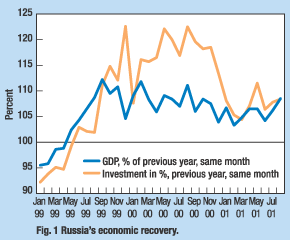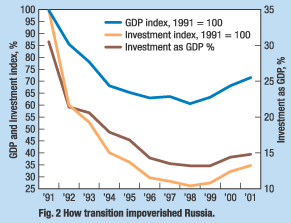Russia marks anniversaries with progress. Ten years after beginning its transition from communism, and more than three years after the financial crash, Russia’s economy is recovering. President Vladimir Putin’s policy is working, and some important reform thresholds – the new tax or land code, for instance – have been crossed. However, by no means does this imply that all problems and potential crises have been left behind. The future, even the near future, could be a bumpy road for Russia. However, the change is truly spectacular, compared to what could be said some years ago. Russia has reacted quite well since the 1998 financial crash. Under a less-than-liberal economic policy, Russia has rebounded since 1999, with 3.5% growth recorded that year (when the IMF had forecast a drop of 7%), followed by 8.2% in 2000, and probably 5.5% for 2001. This trend began much earlier than the oil and gas improvement, Fig. 1.
Pushed down by the East-Asian crisis, commodity and hydrocarbon prices began to move up by summer 1999, but they were not a growth factor before the end of 1999’s third quarter. Meanwhile, the consumption goods industry (food processing among others) that has been the main recovery driver began to rebound as early as mid-November 1998. By mid-1999, investment followed production. Here, too, the growth was impressive and not concentrated in raw materials. Russian enterprises used profit generated by the low exchange rate to modernize products and production processes. Quality improved spectacularly in some sectors during 1999 and 2000, and so did labor productivity. Inflation has been controlled as smoothly as possible since the crash. From a 1998 peak of 84% – understandable after the financial crisis – inflation went down to 36.5% in 1999, and 20.7% in 2000. For 2001, the inflation rate was again somewhere around 20%. Not only was the budget deficit reduced, but the increasing economic activity level also translated into much higher tax revenues. A primary surplus was experienced in 1999, 2000 and 2001. Thus, Russia reached a target that originally seemed out of reach between 1992 and 1998. The combination of strong nominal devaluation and good control of the inflation level translated into a significant actual change. It reduced imports measureably and boosted exports, even before the rise in oil prices. The trade balance improved quickly, in a very significant way. A $40-billion surplus for 2001 was reached, even with oil and gas prices decreasing since September. The current trend in hydrocarbon prices will probably not affect Russian economic growth. It could, however, put some new strain on the budget, because a significant part of budget revenues is coming from export taxes. However, despite all this good news, Russia is still a very poor country. Neither the GDP nor the investment figure has returned to pre-transition levels, which is an understandable concern for authorities and the population, alike, Fig. 2. So, Russia still needs a long period (7 to 10 years) of fast growth and qualitative change, just to overcome transition results. If we assume a sustained, average yearly growth rate of 4%, Russia would not reach the pre-transition GDP level before 2011. One wonders if Russia’s population will wait so long. Declining living standards are producing what is now called in Russia (and also in most Eastern European countries), transition fatigue.
If we assume a higher rate, perhaps 7% annually, then 1990’s level would be reached by 2006. In this scenario, Russian GDP by 2011 would be 40% over the 1990 level. This sounds impressive, but the actual truth is quite different. A 40% rate over 21 years (1990 – 2011) would translate into 1.6% annual growth, leaving Russia still far behind European and U.S. economies, long-term. This is where Russia stands amid the new international realities fueled by tragic September 11 events and the war against terrorism. This context certainly is beneficial for Russia. It vindicates part of President Putin’s previously criticized policy in Chechnya. Through close relations with the Northern Alliance, Russia is making gains in Central Asia. By supporting U.S. policy from the beginning, Russia was positioned to dramatically increase its international status. Close links with NATO, and the new "strategic partnership" with the EU (unveiled when Putin came to Brussels last October), contribute to the new status. These new links are also partly tactical – Russia is now in a much better position to bargain with Washington on some important geo-strategic issues. However these links, particularly with the EU, are also part of a new strategy. Putin wants to anchor Russia to the West, despite whatever disagreements still exist. He sees such a strategy providing more opportunities than constraints. Jacques Sapir is Professor of economics at EHESS-Paris and at the Higher School of Economics in Moscow. He is a regular contributor to this column. |
- Mixed outlook for activity on the UK Continental Shelf (December 2023)
- First Oil: Sorting through the muddled mess (November 2022)
- First Oil: Electricity problems reflect poor energy/resource policy (August 2022)
- First Oil: A tale of two “windfalls” (June 2022)
- The ESG perspective: A day without oil? (April 2022)
- Executive viewpoint: Texas oil and gas can save Europe—again (April 2022)
- Applying ultra-deep LWD resistivity technology successfully in a SAGD operation (May 2019)
- Adoption of wireless intelligent completions advances (May 2019)
- Majors double down as takeaway crunch eases (April 2019)
- What’s new in well logging and formation evaluation (April 2019)
- Qualification of a 20,000-psi subsea BOP: A collaborative approach (February 2019)
- ConocoPhillips’ Greg Leveille sees rapid trajectory of technical advancement continuing (February 2019)





